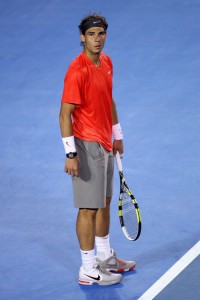Australian Open, Quarterfinals
Ferrer d. Nadal, 6/4 6/2 6/3
Of the four men’s quarterfinals being contested at this year’s Australian Open, there was only one whose result was almost utterly beyond doubt. Rafael Nadal’s record against nearly everyone has been impeccable of late, and he was playing someone tonight, suggesting he would have the edge.  The fact that he was playing another Spaniard – his career so far demonstrates scant fear towards those presumptuous enough to be born in the same country – seemingly put it beyond doubt. True, the countryman was David Ferrer, the only Spaniard ever to defeat him in Grand Slam play, but that was years ago, in another place.
The fact that he was playing another Spaniard – his career so far demonstrates scant fear towards those presumptuous enough to be born in the same country – seemingly put it beyond doubt. True, the countryman was David Ferrer, the only Spaniard ever to defeat him in Grand Slam play, but that was years ago, in another place.
Still, when you’re going up against a guy who’s won 25 Grand Slam matches in a row, you’ll take everything you can get. But would Ferrer have taken any solace in this random stat: it is a year to the day since Nadal’s knee imploded whilst copping a ferocious barrage from Andy Murray in the 2010 Australian Open. Friendship and decency would dictate not, quite aside from the sheer unlikelihood of something like that happening again, today. Except it did.
You doubtless know how it went down, how two games into the match (following a good 20 minutes of grind) Nadal strained his left hamstring, and departed the court for extended treatment at the next change of ends. He returned, having resolved to play on if he could – he later confided that he’d ‘hated’ that moment of default last year – but his look was grim, and his serve speed well down. Hamstrung, he toiled until the end. Ferrer was unrelenting, and it is not unreasonable to suggest he might well have troubled Nadal had the latter been fully fit. We’ll never know, and the story of the night was not Ferrer, which is a shame for a nice guy moving into his second major semifinal. But it is what it is, and Nadal was chasing history.
History escaped, again. The mystique of the Grand Slam is considerable, and it will only gain lustre after tonight. Nadal is fond of telling anyone willing to listen how ‘impossible’ nearly every task on a tennis court is, whether it is beating a geriatric qualifier, or winning four majors in a row. Turns out, this time, he was right, though I suspect even he was late in believing it. As the reality sank in, his face said it all, which means the supplementary commentary supplied by my television was completely superfluous. In case it wasn’t clear, the close-ups of the world No.1 wiping away angry tears during a changeover late in the match made it crystalline. We were talked through that, too. Nadal’s face – stricken and furious – proved a valuable corrective to the sometimes overwhelming sense that he is an inhuman and unstoppable robotic killing machine, recovering again and again from seemingly mortal blows, returning to the fray to visit bloody retribution on Roger Federer. A few tears did Andy Murray’s image no harm, and surely no one is exulting in this outcome. Shadenfraude has its limits, except on the internet.
In his press conference afterwards Nadal was philosophical, pointing out to the hushed room that any tennis career has its high and low points, and that of late the highs have been abundant. Had he been poetic, he might have recalled these lines, which he should by now know by heart: ‘If you can meet with Triumph and Disaster, and treat those two impostors just the same . . .’

2 Responses to Triumph And Disaster